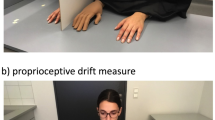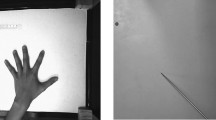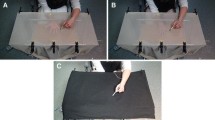Abstract
Increasing evidence suggests that the visual analysis of other people’s actions depends upon the observer’s own body representation or schema. This raises the question of how differences in observers’ body structure and schema impact their perception of human movement. We investigated the visual experiences of two persons born without arms, one with and the other without phantom sensations. These participants, plus six normally-limbed control observers, viewed depictions of upper limb movement under conditions of apparent motion. Consistent with previous results (Shiffrar M, Freyd JJ (1990) Psychol Sci 1:257), normally-limbed observers perceived rate-dependent paths of apparent human movement. Specifically, biologically impossible motion trajectories were reported at rapid display rates while biologically possible trajectories were reported at slow display rates. The aplasic individual with phantom experiences showed the same perceptual pattern as control participants, while the aplasic individual without phantom sensations did not. These preliminary results suggest that phantom experiences may constrain the visual analysis of the human body. These results further suggest that it may be time to move beyond the question of whether aplasic phantoms exist and instead focus on the question of why some people with limb aplasia experience phantom sensations while others do not. In this light, the current results suggest that somesthetic representations are not sufficient to define body schema. Instead, neural systems matching action observation, action execution and motor imagery likely contribute to the definition of body schema in profound ways. Additional research with aplasic individuals, having and lacking phantom sensations, is needed to resolve this issue.


Similar content being viewed by others
References
Berlucchi G, Aglioti S (1997) The body in the brain: neural bases of corporeal awareness. Trends Neurosci 20:560–564
Boonstra AM, Rijnders LJ, Groothoff JW, Eisma WH (2000) Children with congenital deficiencies or acquired amputations of the lower limbs: functional aspects. Prosthet Orthot Int 24:19–27
Brugger P, Kollias SS, Müri RM, Crelier G, Hepp-Reymond M-C, Regard M (2000) Beyond re-membering: phantom sensations of congenitally absent limbs. Proc Natl Acad USA 97:6167–6172
Buccino G, Binkofski F, Fink GR, Fadiga L, Fogassi L, Gallese V, Seitz RJ, Zilles K, Rizzolatti G, Freund H-J (2001) Action observation activates premotor and parietal areas in a somatotopic manner: an fMRI study. Eur J Neurosci 13:400–404
Burchard JM (1965) Zur Frage nach der Natur von Phantomerlebnissen bei angeborener Gliedmassenverstümmelung. Arch Psychiatr Z Neurol 207:360–377
Ehrsson HH, Spence C, Passingham RE (2004) That’s my hand! Activity in premotor cortex reflects feeling of ownership of a limb. Science 305:875–877
Flor H, Elbert T, Mühlnickel W, Pantev C, Wienbruch C, Taub E (1998) Cortical reorganization and phantom phenomena in congenital and traumatic upper-extremity amputees. Exp Brain Res 119:205–212
Funk M (2001) Mentale Rotation von Händen und körperfremden Objekten: Untersuchungen mit Kindern und Erwachsenen mit und ohne kongenitalem Handmangel. Unpublished Master’s Thesis, Department of Experimental and Developmental Psychology, University of Zurich, Zurich, Switzerland
Funk M, Brugger P (2002) Visual recognition of hands by persons born with only one hand. Cortex 38:860–863
Gowers WR (1879) Clinical cases. The brain in congenital absence of one hand. Brain 1:386–390
Grezes J, Decety J (2001) Functional anatomy of execution, mental simulation, observation, and verb generation of actions: a meta-analysis. Hum Brain Mapp 12:1–19
Grouios G (1996) Phantom limb perceptuomotor “memories” in a congenital limb child. Med Sci Res 24:503–504
Halligan PW (2002) Phantom limbs: the body in mind. Cogn Neuropsychiatry 7:251–268
Halligan PW, Zeman A, Berger A (1999) Phantoms in the brain. Question the assumption that the adult brain is “hard wired”. Br Med J 319:587–588
Hamzei F, Liepert J, Dettmers C, Adler T, Kiebel S, Rijntjes M, Weiller C (2001) Structural and functional cortical abnormalities after upper limb amputation during childhood. Neuroreport 12:957–962
Henderson WF, Smyth GE (1948) Phantom limbs. J Neurol Neurosurg Psychiatry 11:88–112
Hunt SMJ (1994) MacProbe: a Macintosh-based experimenter’s workstation for the cognitive sciences. Behav Res Methods Instrum Comput 26:345–351
Knecht S, Hennigsen H, Höhling C, Elbert T, Flor H, Pantev C, Taub E (1998) Plasticity of plasticity? Changes in the pattern of perceptual correlates of reorganization after amputation. Brain 121:717–724
Lacroix R, Melzack R, Smith D, Mitchell N (1992) Multiple phantom limbs in a child. Cortex 28:503–507
Melzack R (1990) Phantom limbs and the concept of a neuromatrix. Trends Neurosci 13:88–92
Melzack R, Israel R, Lacroix R, Schultz G (1997) Phantom limbs in people with congenital limb deficiency or amputation in early childhood. Brain 120:1603–1620
Nico D, Daprati E, Rigal F, Parsons L, Sirigu A (2004) Left and right hand recognition in upper limb amputees. Brain 127:120–132
Parsons LM (1994) Temporal and kinematic properties of motor behavior reflected in mentally simulated action. J Exp Psychol Hum Percept Perform 20:709–730
Poeck K (1964) Phantoms following amputation in early childhood and in congenital absence of limbs. Cortex 1:269–275
Poeck K (1969) Phantome nach Amputation und bei angeborenem Gliedmassenmangel. Dtsch Med Wochenschr 94:2367–2374
Ramachandran VS, Hirstein W (1998) The perception of phantom limbs: the D.O. Hebb Lecture. Brain 121:1603–1630
Reed CL, Farah MJ (1995) The psychological reality of the body schema: a test with normal participants. J Exp Psychol Hum Percept Perform 21:334–343
Rizzolatti G, Fogassi L, Gallese V (2001) Neurophysiological mechanisms underlying the understanding and imitation of action. Nat Rev Neurosci 2:661–670
Sebanz N, Knoblich G, Prinz W (2003) Representing others’ actions: just like one’s own? Cognition 88:B11–B21
Shiffrar M, Freyd JJ (1990) Apparent motion of the human body. Psychol Sci 1:257–264
Shiffrar M, Freyd JJ (1993) Timing and apparent motion path choice with human body photographs. Psychol Sci 4:379–384
Skoyles JR (1990) Is there a genetic component to body schema? Trends Neurosci 13:409
Stevens JA, Fonlupt P, Shiffrar M, Decety J (2000) New aspects of motion perception: selective neural encoding of apparent human movements. Neuroreport 11:109–115
Stoeckel MC, Jörgens S, Witte OW, Seitz RJ (2005) Reduced somatosensory hand representation in thalidomide-induced dysmelia as revealed by fMRI. Eur J Neurosci 21:556–562
Valentin G (1836) Ueber die subjectiven Gefühle von Personen, welche mit mangelhaften Extremitäten geboren sind. Rep Anat Physiol 1:328–337
Weinstein S, Sersen EA, Vetter RJ (1964) Phantoms and somatic sensation in cases of congenital aplasia. Cortex 1:276–290
Acknowledgments
This work was supported by the Swiss National Science Foundation (grant no. 3100–67168.01 to PB) and the National Institutes of Health (grant EY12300 to MS). Preliminary data were presented at the Joint Meeting of the Association of British Neurologists and the Swiss Neurological Society (London, September 20–22, 2000). We thank Marianne Regard for assistance in participant recruitments, Peter Roth for providing the drawings on the response sheets and Malgorzata Roos for statistical consulting. The constructive comments by two anonymous referees are likewise acknowledged.
Author information
Authors and Affiliations
Corresponding author
Rights and permissions
About this article
Cite this article
Funk, M., Shiffrar, M. & Brugger, P. Hand movement observation by individuals born without hands: phantom limb experience constrains visual limb perception. Exp Brain Res 164, 341–346 (2005). https://doi.org/10.1007/s00221-005-2255-4
Received:
Accepted:
Published:
Issue Date:
DOI: https://doi.org/10.1007/s00221-005-2255-4




